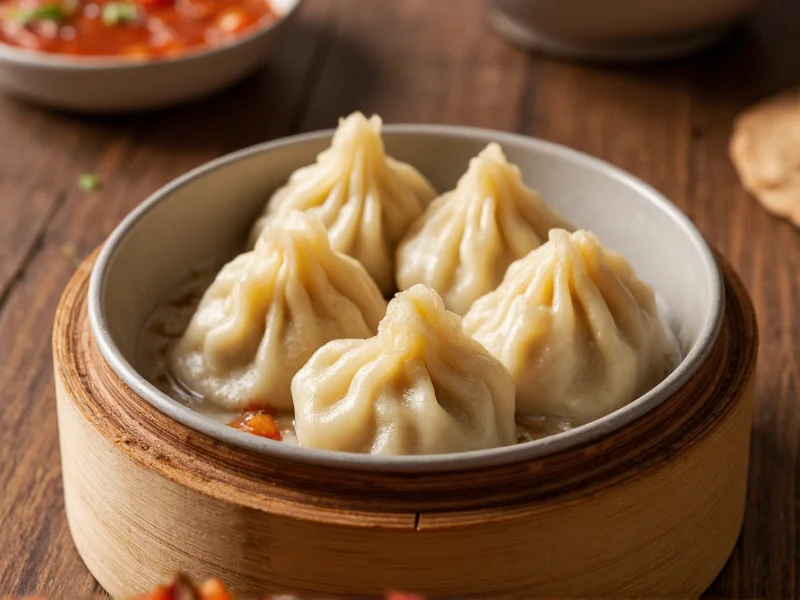These delicate culinary creations represent one of Chinese cuisine's most technically impressive dishes. Unlike regular dumplings, authentic Chinese soup dumplings feature a thin wrapper encasing both solid filling and liquid broth that transforms during the cooking process. The magic happens through careful preparation of the aspic—a gelatin-rich broth that solidifies when chilled but liquefies when steamed.
The Science Behind the Soup
Creating proper soup dumplings requires understanding the precise chemistry of the aspic. Chefs prepare a rich meat or poultry broth, then cool it until the natural gelatin causes it to set into a jelly-like consistency. When chopped fine and mixed with the filling, this aspic melts during steaming, creating the signature soup interior.
| Component | Traditional Preparation | Key Function |
|---|---|---|
| Wrapper | Wheat flour, water, slight alkalinity | Thin yet strong enough to contain liquid |
| Filling | Minced pork, crab, or vegetarian options | Provides flavor base for the soup |
| Aspic | Gelatinized broth (pork, chicken, or crab) | Creates the liquid soup when heated |
| Seasonings | Ginger, scallions, Shaoxing wine | Enhances flavor without overwhelming |
Historical Origins and Regional Variations
Xiaolongbao (which translates to “small basket buns”) originated in the Jiangnan region of China, particularly associated with Nanxiang town near Shanghai. Historical records suggest their development during the late 19th century, though soup-filled dumpling concepts existed earlier in Chinese culinary tradition.
Regional variations showcase China's culinary diversity:
- Shanghai-style: Larger dumplings with pork filling and rich broth, often featuring crab roe
- Taiwanese versions: Sometimes include pork gelatin cubes visible through translucent wrappers
- Changzhou style: Known for having precisely 18 pleats and a slightly sweeter broth
- Wuhan soup dumplings: Feature a thinner wrapper and more delicate broth
Traditional Preparation Techniques
Mastering authentic Chinese soup dumplings requires precise technique. The wrapper must be rolled thinner at the edges than the center to prevent tearing while maintaining structural integrity. Each dumpling typically features 14-24 precise pleats, with Shanghai style traditionally having 18.
The steaming process demands careful temperature control. Bamboo steamers allow proper moisture regulation, while metal steamers can create overly soggy wrappers. Professional chefs monitor steaming time to the second—typically 8-10 minutes—to achieve the perfect balance where the wrapper sets without breaking and the aspic fully liquefies.
Proper Soup Dumpling Etiquette
Enjoying Chinese soup dumplings properly involves specific techniques to avoid burns and fully appreciate the flavors:
- Place the dumpling on a spoon with the pleat side up
- Create a small opening with chopsticks or teeth
- Sip the hot broth first before eating the dumpling
- Optional: Add ginger shreds and black vinegar to enhance flavor
- Never bite directly into a whole dumpling—this causes scalding broth to spill
This careful approach preserves the delicate balance of flavors and prevents the common mistake of burning oneself on the 160°F+ broth inside. Traditional accompaniments include Zhenjiang vinegar and matchstick ginger, which cut through the richness of the pork broth.
Modern Interpretations and Global Adaptations
While traditional pork xiaolongbao remain most popular, contemporary chefs have expanded the concept with innovative variations. Some notable adaptations include:
- Lobster and truffle soup dumplings in high-end restaurants
- Vegan versions using mushroom and vegetable broths
- Seasonal variations featuring crab in autumn or bamboo shoot in spring
- Frozen commercial versions that maintain quality through flash-freezing
Despite these innovations, purists maintain that authentic Chinese soup dumplings must feature handmade wrappers, carefully prepared aspic, and precise steaming—elements difficult to replicate in mass production. The best versions remain those prepared fresh in specialized restaurants where chefs dedicate years to mastering the craft.
Where to Experience Authentic Soup Dumplings
For those seeking genuine Chinese soup dumplings, certain regions and establishments stand out. Shanghai remains the epicenter, with老字号 (lão zìhào—established老字号) restaurants like Jia Jia Tang Bao and Lü Bo Gou offering decades of perfected technique. Outside China, cities with significant Chinese communities often feature exceptional soup dumpling specialists, particularly in neighborhoods with strong Shanghainese culinary traditions.











 浙公网安备
33010002000092号
浙公网安备
33010002000092号 浙B2-20120091-4
浙B2-20120091-4